Essential Kitesurf Maps: Locations, Techniques, Gear


Intro
Kitesurfing is not just a sport; it's an experience that marries the thrill of surfing with the power of the wind. Navigating this exhilarating landscape requires not only skill but also knowledge, particularly when it comes to using kitesurf maps. These maps act as a guiding compass for kiteboarders, revealing hidden gems of locations, potential hazards, and the best techniques tailored for various environments. By understanding how to read these maps, enthusiasts can elevate their ride and ensure safety while pursuing their passion.
The subsequent sections will dive into the intricacies of kitesurf maps, exploring essential equipment insights, exploring techniques for varying skill levels, and offering resources that enhance overall riding experience. So, let’s get into the wind and waves.
Understanding Kitesurf Maps
Kitesurf maps serve as a critical navigational tool for kiteboarders, unlocking a world of possibilities when it comes to choosing where to ride. The importance of comprehending these maps cannot be overstated; they contain vital information about wind conditions, water depths, and local hazards. For both novices and experienced riders, being adept at reading kitesurf maps can significantly improve their overall experience and safety. When the wind picks up, the last thing you want is to be scratching your head over a chaotic map while missing out on the perfect session.
Definition and Purpose of Kitesurf Maps
Kitesurf maps are specialized charts designed to indicate various aspects of potential kitesurfing locations. These maps are crafted with the specific needs of kiteboarders in mind, highlighting areas with optimal wind conditions and safe water conditions. In essence, they are the roadmaps to adventure on the water.
The primary purpose of these maps stretches beyond mere geography. They inform users about:
- Wind directions: A crucial factor in kitesurfing, understanding wind patterns helps in choosing the right launch sites.
- Water depth: Shallow areas can pose hazards, especially for beginners.
- Local amenities: Information such as nearby schools, rental shops, and food options enhances the kitesurfing experience.
- Regulations: Knowing the local rules ensures respectful and safe use of the ocean environment.
In sum, these tools serve as the foundational first step in planning an enjoyable kitesurfing outing. The knowledge gained from kitesurf maps can mean the difference between a productive day riding the waves and a frustrating experience.
Key Features of Kitesurf Maps
To navigate effective kitesurfing, understanding the key features of these maps is paramount. Here are some of the critical elements:
- Legend and Symbols: Every map comes with a legend, defining symbols that indicate wind speeds and types of water. Familiarizing yourself with these symbols enhances your ability to make informed choices.
- Topographical Details: Understanding the physical layout of the land and sea is vital. For example, surrounding barriers can affect wind flow. Not every beach is equal in terms of safety and utility.
- Local Knowledge: Maps often incorporate insights from the local kitesurfing community. These notes might point out hidden spots, usual swell patterns, or even the best times to hit the waves.
- Weather Information: Some maps may include weather forecasts or integrate with digital platforms to offer real-time updates. In a sport that relies heavily on weather, this feature can be invaluable.
Furthermore, modern kitesurf maps have started adopting digital formats, which can be more interactive and informative than traditional printed ones. As you explore, pay attention to the quality of the maps you choose; a well-designed map can greatly enrich your kitesurfing experience while a poorly made one might leave you stranded in the lurch.
Types of Kitesurf Maps
Understanding the various types of kitesurf maps is crucial for both novice and seasoned riders. Each map brings its own unique benefits and nuances. Knowing when and how to utilize these maps can drastically improve your overall kitesurfing experience. Whether you're searching for the perfect wind conditions or seeking a less crowded spot, the right map can make all the difference.
Digital Kitesurf Maps
Digital kitesurf maps have taken the scene by storm, especially in our tech-savvy world. They offer a plethora of features that cater to the modern rider's needs. Users can access them on their smartphones, tablets, or laptops, enabling quick and easy navigation.
Some benefits of digital kitesurf maps include:
- Real-time Updates: These maps often provide live data on wind conditions and weather, which can change at the drop of a hat. Riders can check the current state before they head out.
- User Accessibility: Many digital maps are community-driven. Users can upload their own data, recommending hidden gems or pinpointing hazards that aren’t marked on traditional maps.
- Layered Information: Different layers can show wind patterns, tides, and even topographical details, giving a comprehensive view of the selected spot.
However, there are some considerations:
- Dependence on Battery Life: It's essential to have your device charged before venturing out, as running out of battery could leave you in a bind.
- Signal Issues: Some remote areas might not have cell coverage, making it hard to retrieve data when you need it the most.
Printed Kitesurf Maps
While digital maps have their advantages, printed kitesurf maps hold a particular charm and practicality that can't be ignored. These maps are tangible and don't rely on technology, making them a reliable choice in places with weak signals or while out on the water with no power outlets in sight.
Here are some pluses of using printed kitesurf maps:
- Durability: They tend to be sturdier, often waterproof or at least resistant to the spray of the ocean, so you can keep them handy without fear of damaging them.
- No Battery Required: There's the clear advantage of being battery-free. As long as you can read, you're good to go.
- Ease of Use: For those who may not be tech-savvy, printed maps provide a straightforward way to navigate without the fuss of apps or devices.
However, printed maps come with their own limitations:
- Static Information: They can't provide updates on changing conditions; what’s accurate when printed may be outdated by the time you arrive.
- Limited Detail: While they tend to cover the essentials well, they may lack the in-depth features that a good digital map offers.
How to Interpret Kitesurf Maps
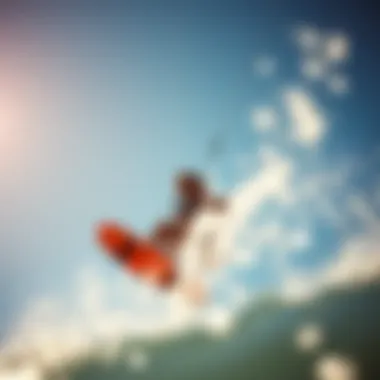
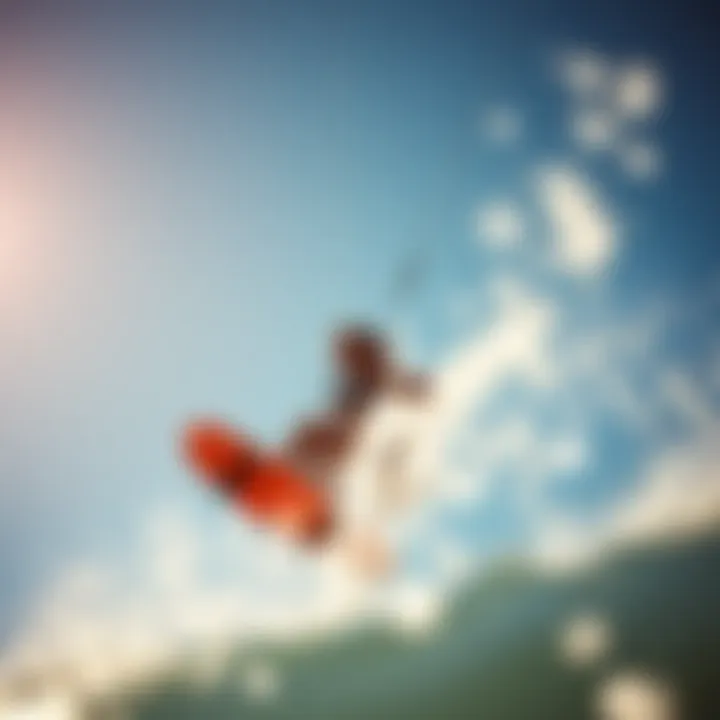
Interpreting kitesurf maps is a vital skill for any kiteboarder looking to enhance their experience on the water. These maps do not just hint at where to sail; they provide a deeper understanding of the conditions that can elevate or compromise a session. Knowing how to read the nuances of a kitesurf map can significantly affect your safety and overall enjoyment.
Effective interpretation allows riders to select the best spots based on wave height, wind direction, and other environmental factors. Plus, being able to decipher these maps contributes to better decision-making, helping you avoid spots that may not be suitable, especially for those still finding their footing in the sport or for seasoned pros pushing for perfect conditions.
Understanding Symbols and Legends
Every kitesurf map comes with its own set of symbols and legends, which may initially seem perplexing if you're not familiar with them. However, take the time to familiarize yourself with these markings, and they can become like a second language, guiding you confidently through your session.
Typically, you’ll find icons representing different types of conditions and features:
- Wind Direction Arrows: These show how the wind is expected to blow. It’s crucial to pay attention to these, as wind direction can make or break your experience—choosing the right spot relative to these arrows can lead to better control and stability while riding.
- Water Depth Indicators: Certain maps indicate shallow areas and depth ranges. This is essential, especially for those who dare to ride in locations with rocky shorelines or shallow reefs. Being aware can prevent a nasty wipeout.
- Hazard Warnings: Look out for signs warning of obstacles like rocks, shallows, or strong currents. These icons are your guardians for safe navigation.
"Knowing how to interpret kitesurf maps is as crucial as having the right gear; it can be the difference between a stellar session and a trip to the ER."
Taking a moment to get to grips with the visual codes not only boosts your confidence on the water but also allows for deeper interactions with other kiteboarders discussing locations and conditions.
Reading Wind Patterns
Wind patterns are the heartbeat of kitesurfing—without them, there's no ride worth talking about. Wind maps illustrate not just where the wind is blowing from but also its speed and stability.
When observing wind patterns on your map:
- Look at Wind Speeds: Often visualized with lines or varying colors, higher wind speeds can make for a wild ride, delightful for experts but daunting for younger riders. Knowing the expected speed can determine if the spot is suitable based on your skill level.
- Identify Consistency: Some spots might have a steady flow, while others might show fluctuations. Knowledge of how steady the wind is in a given area, as per the mapping, is essential. Gaps in the flow could signal unstable gusts, making it tricky.
- Understand Thermal Winds: In coastal areas, you may encounter local wind patterns influenced by temperature changes. Recognizing these can give you the upper hand, especially during summer months when thermal winds can whip up unexpectedly.
In essence, reading wind patterns is not merely a technical skill; it’s about developing an intuition for how different conditions will affect your ride. The more you analyze maps and adapt, the more you can tailor your sessions for optimal enjoyment, allowing every rider from novice to expert to harness the power of the wind.
Choosing the Right Locations
Selecting an ideal spot to kitesurf is paramount for both safety and enjoyment. A well-chosen location lets riders harness favorable wind conditions, enjoy smooth water surfaces, and access necessary amenities. In this section, we will explore the intricacies of location selection, shedding light on various elements and considerations that come into play when choosing where to kite.
Popular Global Kitesurf Destinations
Globally, certain destinations stand out among the kitesurfing community for their persistent winds and tailored infrastructure catering to kiteboarders. These spots offer a blend of excellent wind conditions and local support, making them prime choices for enthusiasts.
- Boracay, Philippines: A picturesque island with vibrant blue waters and reliable trade winds. The areas around White Beach and Bulabog Beach are especially favorable for kitesurfing.
- Cabo Verde: With islands such as Sal and Boa Vista, Cabo Verde offers consistent trade winds and warm waters, attracting both beginners and seasoned riders.
- Cape Town, South Africa: Renowned for its impressive scenery and strong winds, especially during the summer months. The beaches at Bloubergstrand provide breathtaking views of Table Mountain.
- Tarifa, Spain: Known as the wind capital of Europe. It has various spots suitable for different skills, plus a lively kitesurfing scene.
This selection teaches us that successful locations not only meet immediate kitesurfing needs but also come with a community, culture, and the right vibe, enhancing the overall experience.
Local Spots: Community Recommendations
Often, the best recommendations come from local riders who understand the nuanced dynamics of their home spots. Engaging with community-led resources can yield insights that typical guides may overlook.
- Reputable Kitesurf Schools: Many local schools can provide valuable information regarding ideal spots based on your skill level. They often organize community rides, where you can meet fellow enthusiasts.
- Local Forums and Facebook Groups: Platforms like Reddit and Facebook are gold mines for suggestions, ranging from hidden gems to seasonal conditions. Observations made by locals can highlight less popular beaches that might have calmer waters or less crowded wind conditions.
- Kitesurfing Events: Participating in events at local spots can give insights into the culture and nuances of the area. Watching experienced riders can offer cues on where to best ride depending on the current conditions.
Engaging with the community fosters connections. Riders who prioritize learning about local recommendations often discover unique spots that offer enjoyable experiences beyond the typical tourist destinations.
Ultimately, choosing the right location significantly influences your kitesurfing adventure, making the difference between a fantastic day on the water and an exasperating one. Understanding diverse locations—both globally recognized and local secrets—opens a world of possibilities for riders at any level.
Safety Considerations in Kitesurfing
In the world of kitesurfing, safety is paramount. This sport, while exhilarating, does not come without its risks. As enthusiasts chase the perfect wind and wave, they must also be aware of the surrounding environment, regulations, and their personal skill level. Neglecting these aspects can lead to dangerous situations. To bolster the kitesurfing experience, understanding safety considerations deeply is crucial.
Understanding Local Regulations
Each kitesurfing spot may come with its own set of local regulations. These rules establish guidelines for safe kiting, minimizing potential conflicts with other beachgoers, wildlife, or natural habitats. Always check for no-kite zones, which often exist near marinas or designated swimming areas. Compliance not only keeps you safe but also promotes positive relations with other water users.
When planning a session, familiarize yourself with local ordinances. Some places may require a permit to kitesurf. Additionally, be aware of conditions such as tide schedules and seasonal restrictions. For instance, areas like the Outer Banks in North Carolina have specific timing where certain sections are most suitable for kiting.
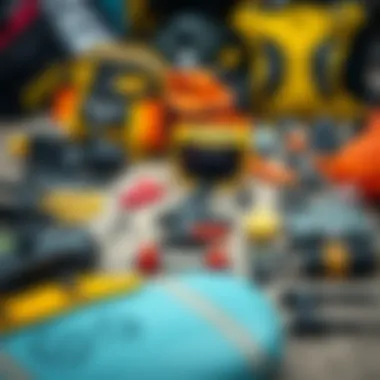
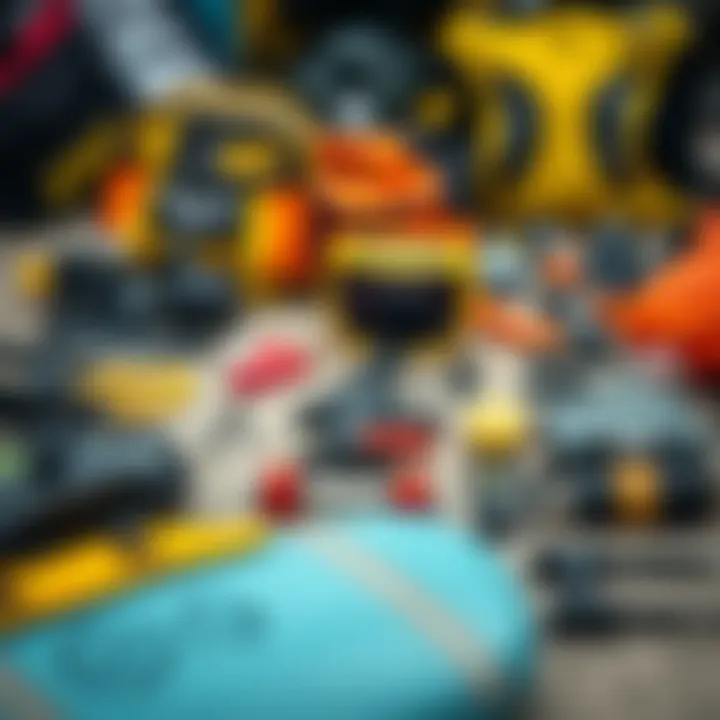
It's advisable to connect with local kitesurfing clubs or instructors you can meet online through forums like Reddit or Facebook groups. They often provide real-time insights about regulations and developments in the area which could affect your visit.
"A good kitesurfer never ignores local regulations. They help to ensure safety and enjoyment for everyone."
Assessing Environmental Risks
Environmental risks are another significant facet that every kitesurfer should consider. While the thrill of speeding over water has its charms, this excitement can rapidly turn sour if one doesn’t pay attention to weather patterns and potential hazards. Before heading out, check the forecast not just for wind speed but also for factors like wave height and storm developments.
Strong currents, sudden weather changes, or obstacles submerged beneath the water can all lead to accidents. Understanding these aspects is essential. Many online platforms and apps provide real-time updates regarding local weather conditions and hazards. Tools such as Windy or WindFinder can be a lifeline, keeping you informed of the conditions for optimal safety.
Furthermore, wildlife should not be overlooked. Certain coastal areas are home to local species, like seals or birds, which might be affected by kitesurfing activities. Being mindful of their habitats means respecting the balance of nature and contributing to sustainability efforts in kitesurf locations.
To sum up, the adventure of kitesurfing thrives on a foundation of safety and awareness. Recognizing and respecting the local regulations, and constantly assessing environmental conditions, can make the difference between a memorable session and a hazardous one. Stay informed, stay safe, and enjoy the ride.
Kiteboarding Techniques
Kiteboarding techniques are a crucial aspect of mastering the sport, influencing not only performance but also safety and enjoyment on the water. Understanding these techniques empowers kiteboarders to harness the wind's energy effectively, navigate different conditions, and push their limits. Whether you're a novice or seasoned rider, learning these skills enhances your overall experience, helping you progress and remain engaged with this thrilling pursuit.
Basic Techniques for Beginners
For those just starting their journey into kitesurfing, grasping the fundamental techniques is essential. These techniques lay the groundwork for safe riding and successful progression. Here’s a breakdown of some vital skills:
- Neutral Positioning: Maintaining a neutral body stance on the board allows for better control. Keep your weight centered and knees slightly bent, which facilitates balance.
- Kite Control: Familiarity with the kite is a must. This includes launching, landing, and flying the kite in a proper figure-eight motion. Such control is not just about handling the kite but understanding its responsiveness to wind changes.
- Water Starts: The water start is the gateway to riding. Position the board at a 45-degree angle, pull the kite from a low position to catch wind, and gradually stand up while steering the kite overhead. Timing is critical here—too early and you'll tumble, too late, and you'll be dragged.
- Riding Technique: Once up on the board, keep looking forward and use your back leg to steer the board in the right direction. An important point for beginners is to not overthink it—let your body flow with the motion of the board and the wind.
"Mastering basic techniques sets the tone for all your future kiteboarding endeavors. It's like learning to walk before you run—solid fundamentals lead to greater successes later on."
Advanced Maneuvers for Experienced Riders
As riders gain confidence and experience, advanced techniques become paramount for enhancing one’s skill set and riding style. These maneuvers often elevate the thrill of kiteboarding while also challenging a rider's limits. Here are several advanced techniques that experienced kiteboarders often focus on:
- Jumping: This involves generating lift by pulling sharply on the back of the bar while edging hard on the board. Timing your kite with the wind is necessary to achieve maximum height. Riders often aim to land safely by preparing for the impact with bent knees.
- Tricks: Maneuvers such as backflips, spins, and grabs become achievable with consistent practice. Each trick demands precise kite control and body positioning, aligning the kite’s movements with your rotations.
- Transitions: Smooth transitions from toe-side to heel-side riding not only look impressive but also improve your riding flow. Achieving clean, effortless transitions requires balancing pressure between feet and adjusting kite position in accordance with the direction change.
- Waveriding: For those kitesurfing in surf spots, utilizing wave energy adds another layer of challenge and enjoyment. Mastering the balance between riding the wave and controlling the kite requires a keen understanding of the ocean’s dynamics.
In summary, both basic and advanced techniques are integral to the kitesurfing experience, providing essential skills that enhance safety, control, and overall enjoyment. As riders grow in their abilities, their relationship with the kite and the water deepens, paving the way for lifelong passion and exploration in this exhilarating sport.
Essential Gear for Kitesurfing
When diving into the world of kitesurfing, one cannot overstate the importance of having the right equipment. It isn’t just about having flashy gear; it’s about safety, performance, and enjoyment. The right tools can mean the difference between a delightful day on the water and a harrowing experience. Kitesurfing gear is a unique blend of technology and personal preference, making the selection process both essential and intriguing.
Kite Selection: Size and Type
Choosing a kite is arguably one of the most significant decisions a kitesurfer will make. The right kite can catapult your skills forward while the wrong choice can quickly leave you frustrated and underwhelmed. Here are some considerations:
- Size: Kites come in various sizes, and the perfect size depends on your weight, skill level, wind conditions, and the type of riding you wish to undertake. A good rule of thumb is that lighter wind requires larger kites, while stronger winds call for smaller ones.
- Type: The main types are the C-kite, all-around kite, and delta kite. Each has its unique characteristics. For instance, C-kites are known for their unyielding performance in jumps and tricks, while delta kites tend to be more user-friendly for beginners, offering better stability.
"Selecting the right kite is like finding the right partner; it takes time, experimentation, and a healthy dose of intuition."
Additionally, consider how the kite's construction impacts durability. Fabrics differ in strength, and the seams need to be robust to withstand the pressures of the sport. Always opt for leading brands known for their rigorous testing and safety standards, such as North Kites or Slingshot, to ensure a reliable choice.
Harnesses, Boards, and Accessories
Once you’ve nailed down the kite, it’s time to look at the supporting gear. Each piece plays a pivotal role in your kitesurfing experience.
- Harnesses: This is your connection to the kite; comfort is key here. A well-fitting harness will help you transfer the kite's power effectively without sacrificing your comfort. There are two primary types: seat harnesses and waist harnesses. Seat harnesses provide more support and are often preferred by beginners, while waist harnesses give greater freedom for movement.
- Boards: Selecting the right board often comes down to personal preference, as well as skill level and water conditions. Freeride boards suit a variety of conditions, while specialty boards like freestyle or wave boards cater to advanced riders looking to specialize. Pay attention to the board's volume and shape, which significantly affect riding style and flow on the water.
- Accessories: Never underestimate the importance of accessories. Items like leash systems prevent your board from floating away if you wipe out. Also, consider a good helmet and impact vest for added safety, especially when learning or attempting new tricks.
Furthermore, tools like bar and lines should never be overlooked. Choose a bar that fits comfortably in your hands and lines that are durable enough for your expected conditions.
In summary, selecting appropriate gear is not just about brand prestige; it’s about understanding your own riding style and preferences. Take the time to research, ask fellow kitesurfers, and consider renting different types of gear before committing to a purchase. The right gear leads to more enjoyable sessions on the water and, ultimately, to a more fulfilling kitesurfing journey.
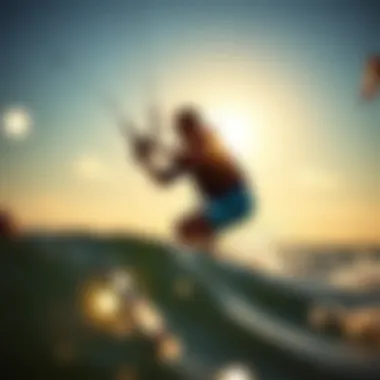
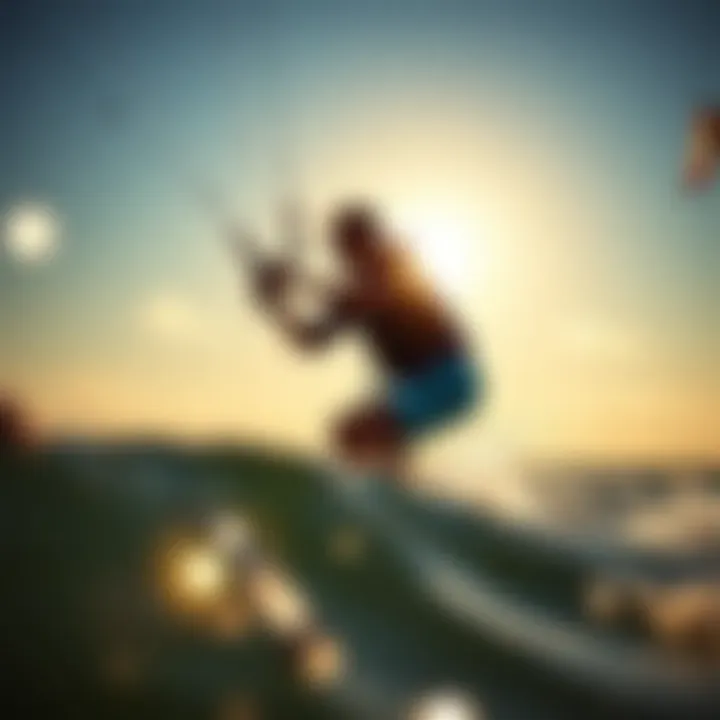
Kitesurf Map Resources
When it comes to kitesurfing, having access to the right resources is key. The sport, while thrilling, has its own set of challenges, and kitesurf maps are invaluable tools for navigating them. They provide kiteboarders with information about locations, conditions, and even potential hazards, ensuring a safer and more enjoyable experience on the water.
Online Platforms for Kitesurf Maps
In the digital age, the variety of online platforms available to kitesurfers is impressive. These platforms offer detailed maps, local conditions, and even community insights, making it easy for riders to plan their outings effectively.
- Windy: This platform gives real-time wind statistics. You can zoom in on specific kitesurf locations and spot potential spots just by checking wind speed and direction.
- iKitesurf: A treasure trove for enthusiasts, this site features both national and global maps, user-uploaded content, and specific spot reviews.
- KiteBuddy: This social platform allows users to share their own kitesurfing experiences, tips, and maps. The community contributions really offer a unique layer of insight that traditional maps might miss.
With the touch of a button, you can locate the best spots for kitesurfing based on real-time data!
Community-Contributed Maps
As useful as well-known online platforms may be, they don't hold a candle to the richness brought by community-contributed maps. These maps are often crafted and shared by local kitesurfers who know the ins and outs of the area intimately.
- Local knowledge: These maps often contain valuable information about less-known spots that might be perfect for a quiet day on the water.
- Safety advisories: Community members often highlight potential dangers or local regulations, keeping newcomers informed.
- Swell updates: Since swell conditions can change rapidly, input from locals can provide timely updates on the best places to catch the best waves.
As the saying goes,
The Future of Kitesurf Mapping
The evolution of kitesurf mapping is as dynamic as the sport itself, boasting a rich tapestry woven with innovation and enthusiasm. As kitesurfing continues to gain traction around the world, the mapping tools that support it are also advancing. This section explores the future landscape of kitesurf maps, underscoring their pivotal role in enhancing the kitesurfing experience.
Technological Innovations in Mapping
The dawn of technology has ushered in an era of sophisticated mapping tools that transcend traditional paper maps. Among the advancements, GPS integrated kitesurf maps stand out. These maps do not just provide locations but also offer live data, showing weather changes, tide information, and real-time wind patterns. Riders can easily access updated conditions, making it possible to better plan their sessions.
Moreover, mobile applications are progressively popularizing kitesurf maps. Apps like Windy and Kitesurfing Live have become essential tools for many enthusiasts. With iPhone or Android devices in hand, users can tap into a wealth of information at their fingertips. Within these applications, community members frequently share insights about optimal conditions and hidden spots, creating a more connected and knowledgeable kitesurfing community.
"The future of kitesurf mapping is not just about locations; it’s about fostering a community built on shared experiences and real-time insights."
Additionally, augmented reality (AR) is on the horizon. Imagine navigating through your chosen spot, using AR to overlay digital information atop the real world. This would allow riders to visualize wind directions, wave heights, and potential hazards directly in their views. Such innovations not only add excitement but also enhance safety, ensuring that both novice and experienced kiteboarders have the tools they need to ride responsibly.
Sustainability in Kitesurf Locations
As the sport continues to flourish, the conversation around sustainability becomes ever more critical. Kitesurf maps of the future will need to incorporate data regarding environmental impact and conservation efforts. With many kitesurfing locations feeling the strain of increased foot traffic, maps can play a role in promoting responsible and sustainable practices among riders.
Future kitesurf maps might highlight areas that are environmentally sensitive, urging riders to tread lightly in unique ecosystems. Such initiatives could foster a culture of conservation within the kitesurf community, creating a mutually beneficial relationship between riders and nature.
Furthermore, educational campaigns should accompany these maps, focusing on the importance of protecting coastal habitats and marine life. Encouraging stakeholders to participate in cleanup events or local conservation projects can promote better stewardship of kitesurfing spots. Together, the kitesurfing community can create and maintain vibrant ecosystems while enjoying the sport.
In summary, the future of kitesurf mapping is not just a visualization of locations, but an ever-evolving blend of technology and environmental awareness, all aimed at nurturing the growth of this exhilarating sport while preserving the natural world. As kiteboarders, embracing these changes will not only enhance our experience but also ensure future generations can share in the thrill of kitesurfing.
The End
When it boils down to kitesurfing, understanding and utilizing kitesurf maps can dramatically enhance your experience on the water. This article has detailed the multifaceted layers of kitesurf maps, from defining their purpose to exploring the various types available. The insights gained not only serve to enrich your outings, but they also empower you with the knowledge necessary to navigate different locations safely and effectively.
Summary of Key Takeaways
The journey through the world of kitesurf maps reveals several key elements:
- Location Identification: Kitesurf maps help you locate the best spots, tailored to your skill level and riding style. This is crucial for both safety and enjoyment.
- Technique Refinement: Understanding the wind patterns and local conditions projected on these maps can lead to better technique and control while riding.
- Equipment Selection: Maps often provide data on optimal equipment choices based on location. This influences your overall performance whether you're a novice or a seasoned rider.
- Safety Awareness: With details about local regulations and environmental risks, kitesurf maps equip you to make informed decisions to ensure a safe experience.
In summary, being well-versed in how to interpret and utilize kitesurf maps not only enriches your practice but also enhances your safety and enjoyment.
Encouragement for Continued Exploration
Even with the insights provided here, the world of kitesurfing is vast and ever-evolving.
- Keep revisiting your local spots and use these maps to discover hidden gems within your reach. You may find your new favorite kitesurfing location just around the corner.
- Engage with communities on platforms like Reddit or Facebook, and consider learning from local riders. They often have invaluable tips that go beyond standard map information.
- Stay abreast of technological developments in mapping tools; these resources are improving constantly and can provide real-time updates on conditions and hazards.
By continuing to explore and engage with kitesurf maps and the broader kiteboarding community, you'll find endless opportunities to grow your skills and experience. Remember, every kitesurfing session is a new adventure waiting to unfold.







